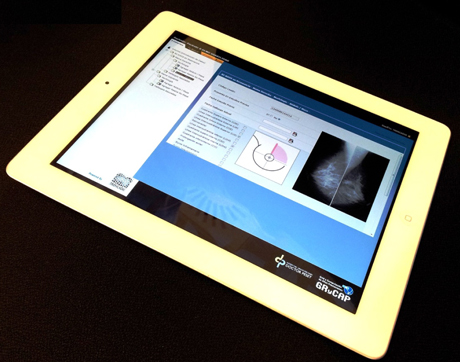by Damià Segrelles, Maite Giménez and Ignacio Blanquer
Intuitive interfaces of mobile devices facilitate the introduction of structured data in breast cancer management, leading to an increase of completeness and accuracy of diagnosis and follow-up evaluations, as well as opening the door for more effective content-based retrieval techniques for clinical decision support.
The exploitation of medical data through distributed computing infrastructures (DCIs) has led to new research lines focused on the extraction of knowledge and the organization of the information to assist radiologists and researchers to retrieve pertinent data from existing medical image repositories. This development not only offers great benefits to training and research, but can also help to improve the clinical management of patients. One significant case is breast cancer screening. Specifically, effective content-based retrieval is based on: (i) the structured representation of the knowledge relative to the images, and (ii) the integration of a means to create and exploit a knowledge database with structured data. However, content-based retrieval is strongly affected by the quality of input data, especially in the medical area. The acquisition of accurate and complete data is a key challenge in clinical healthcare [1].
On the other side, the inherent complexity in the use of DCIs prevents their usage within the wider community. Scientific gateways are being widely used to facilitate the access of scientists to these tools, simplifying the organization of data repositories and the execution of experiments. In the particular case of biomedicine, usability evaluation is widely recognized as critical to the success of any software system with which end users interact [2].
The introduction of mobile computing constitutes a great opportunity for increasing both the quality of introduced data and the content-based retrieval of existing data. Radiology reports are introduced in plain text using voice recognition systems. Coding is limited to conclusions in the best case. Plain text-based retrieval is inefficient as documented in the literature due to the ambiguities of terms and the difficulties in dealing with negative statements. Structured reports are playing a key role in the definition of unequivocal pieces of information for comparisons and data mining.

For this purpose, TRENCADIS [3] (Towards a Grid Environment to Process and Share DICOM Objects) is a technology, based on Grid and Cloud computing, created for securely sharing, organizing and searching medical images. Moreover, it provides a toolkit to support the development of applications that are capable of using heterogeneous, distributed computing and storage resources, made available through TRENCADIS services. TRENCADIS has incorporated a mobile-compatible interface to ease the introduction of structured reports. A prototype has been developed in cooperation with the Hospital Universitario Dr. Peset from Valencia for the diagnosis, follow-up and response analysis of breast cancer.
The complete process of breast cancer management has been coded into nine templates that allow the radiologists to fill in the report faster than using keyboard and mouse without compromising the accuracy and guidance of structured terms. A mobile interface also enables writing the report at the image acquisition point. These components are being integrated in an existing prototype being developed for diagnosis support and research in breast cancer. A usability study will follow the validation of the prototype.
Currently, TRENCADIS software and support is provided to the collaborating centres within research projects and contracts. An open-source distribution of the toolkit is planned for the first term of 2014.
References:
[1] B. Zheng et al: “Interactive computer-aided diagnosis of breast masses: computerized selection of visually similar image sets from a reference library”, Academic Radiology 14(8), pp. 917–927, 2007
[2] C. Maestre et al: “Assessing the Usability of a Science Gateway for Medical Knowledge Bases with TRENCADIS”, J Grid Computing, 10, pp. 665–688, 2012
[3] I. Blanquer, V. Hernández, J.E. Meseguer: “Content-Based Organisation of Virtual Repositories of DICOM Objects”, Future Gener Comput System, 25(6), pp.627–637, 2009.
Please contact:
Ignacio Blanquer
Universitat Politècnica de València, Spain
E-mail:











